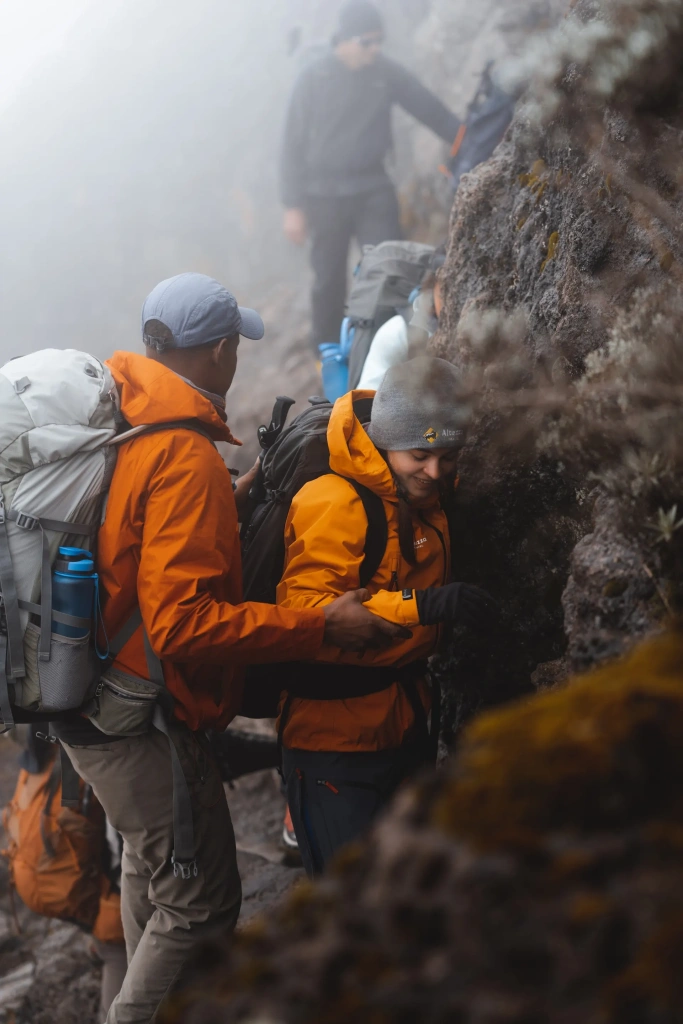The Kissing Rock is a memorable spot along the trail that winds up the Barranco Wall on Mount Kilimanjaro. At this point, the path narrows so much that the only way to pass is by gripping the rock with both hands and pressing your body against it, almost like giving it a kiss. That’s why it’s also known as the Hugging Rock.
But is this section actually dangerous? Has anyone ever died while “kissing” Kilimanjaro? What’s the safest way to cross the Kissing Rock on your way to Uhuru Peak? And why do so many climbers embrace this rock on the Barranco Wall? You’ll find all the answers in this article.
Where is the Kissing Rock located?
The Kissing Rock is located on the Barranco Wall, which rises above the Barranco Valley. The wall itself sits at around 4,000 meters (13,100 feet) above sea level and towers 257 meters (843 feet) above the valley. It's a cliff face with an uneven surface, formed hundreds of thousands of years ago after an eruption of Kibo, the central volcano of Mount Kilimanjaro.
To get from Barranco Camp to Karanga Camp, climbers must ascend this wall if they’re following one of the popular routes: Lemosho, Machame, or Umbwe. The trail runs along the face of the wall in a zigzag path. At one point, it becomes so narrow that climbers must "hug" a large protruding rock to get past it. From the side, it looks like a person is leaning in to kiss the rock. In fact, many climbers really do kiss it.
Why kiss the rock on Kilimanjaro?
For some climbers, it’s a tradition — a quick kiss on the rock while making their way up the trail. Some do it for luck, hoping for a successful summit. Others do it out of gratitude, as if to say thanks to the mountain for allowing them to safely pass that stretch.
Not all climbers kiss the rock — many simply hold onto the outcrop with both hands. It's entirely up to you.
How dangerous is the Kissing Rock?
The Kissing Rock, like the rest of the Barranco Wall, isn’t dangerous. Most of the climb is a steady ascent along a winding path beside the wall. It usually takes 1 to 2 hours, with some of that time spent waiting for the climbers ahead to move along the narrow trail.
The wall may look intimidating when viewed from below at Barranco Camp. But once you're on it, you'll realize there's nothing particularly difficult about it. In general, Kilimanjaro is a safe mountain to climb, as long as you take reasonable precautions and, most importantly, choose a responsible and experienced tour operator.
Not a single person has died at the Kissing Rock. Yes, between 3 and 10 climbers die on Kilimanjaro each year, but the main cause is high-altitude pulmonary edema (HAPE). The Barranco Wall is a safe section that only requires calm and focused movement.
How to safely pass the Kissing Rock?
To get past the Barranco Wall on Kilimanjaro, all you need to do is move carefully and steadily, using your hands to grip the rocks along the trail. Trekking poles aren’t used here, as they would only get in the way. Just follow the guidance of your experienced guides, who will show you exactly where to step and what to hold onto. The most important thing is not to rush — go polepole, as they say in Tanzania.
If you’re afraid of heights, let your guides know in advance. They’re used to helping climbers at the Kissing Rock and can assist two at a time if needed, though this is usually more a safety measure than a necessity. Just look at 86-year-old Angela Vorobeva confidently making her way past the Kissing Rock with the help of Altezza Travel guides. At the time, she set a world record as the oldest person ever to reach the summit of Kilimanjaro!
Ready to “kiss” Kilimanjaro on the Barranco Wall? Start planning your Kilimanjaro climb with Altezza Travel. Our expert guides will lead you safely and confidently all the way to the Roof of Africa.
All content on Altezza Travel is created with expert insights and thorough research, in line with our Editorial Policy.
Want to know more about Tanzania adventures?
Get in touch with our team! We've explored all the top destinations across Tanzania. Our Kilimanjaro-based adventure consultants are ready to share tips and help you plan your unforgettable journey.




















